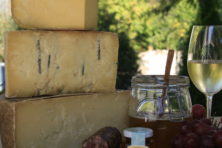The Cheese Insider
- Share
- Tweet
- Pin
- Share
A category of cheeses that dates back to the very first cheeses created, are known as soft or fresh cheese. This includes the following: Cottage Cheese, Cream Cheese, Feta, Mascarpone, Queso Blanco, and Ricotta. To make these cheeses a totally different process is used.
When milk sours naturally, the increased acidity curdles it, separating it into curds and whey. The production used in making fresh cheeses is unique, referred to as “acid-set,” cheese. The milk coagulates with lactic acid starter cultures instead of rennet and enzymes, used in making all other cheeses. The cheese is not cut, pressed or ripened (with the exception of Feta which is pressed in a form).
Cottage Cheese originated in Europe, where housewives made only enough for each family’s consumption. Today this cheese has become very popular in the United States.
Its appearance is bright, creamy white, with relatively small, tender curds. The taste is like fresh milk, only slightly acidic.
Cream Cheese, an American original, became popular in the 1880s. The invention of a separator in the late 1890s made it possible to separate the whey immediately from the hot solids. This process allowed cheesemakers to pack the hot curd, and the shelf life for the finished cheese doubled.
Feta was first made in Greece using milk from sheep, and or goats. Most Feta made here in Wisconsin is made with cow’s milk. Cheesemakers refer to Feta as “pickled” because, after it is pressed into forms, it is packed in brine (salt and water). The brine preserves the cheese much longer than most fresh cheeses. Its texture is crumbly and the flavor is tart and salty.
Mascarpone originated in Italy and was made only during the fall and winter months. It was used strickly as a dessert cheese. In Wisconsin it is made year round and contains 70 percent milk fat, which makes it a triple crème. Many of us know Mascarpone because it is the cheese used in Tiramisu, a very tasty dessert. Its texture is smooth, thick, soft and very creamy. The flavor is rich, buttery, and slightly sweet.
Queso Blanco means “white cheese” in Spanish. Similar cheeses, such as Panela, are made throughout Mexico, South America, and the Caribbean. Most of us get exposed to this type of cheese eating it in Mexican restaurants, usually sprinkled on top of enchiladas, or a number of other dishes. Its texture is crumbly, and this cheese does not melt because of its low moisture content. The taste is mild, fresh, and a bit salty.
Ricotta was created in Italy and uses the whey that remains after the cheesemaker makes Mozzarella and or Provolone. The cheesmaker coagulates the whey protein with heat and acid. Ricotta literally means “recooked.” This process causes the curds to precipitate and rise to the surface, where they are skimmed off and drained. The texture of this cheese is creamy, yet with a slightly grainy curd. The flavor is very mild, with a hint of sweetness.
All the fresh cheeses mentioned offer you some very creative opportunities, with a variety of recipes.
Source: Wisconsin Milk Marketing Board



